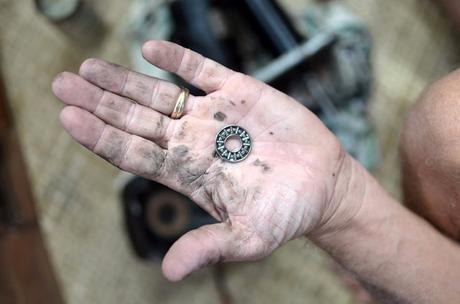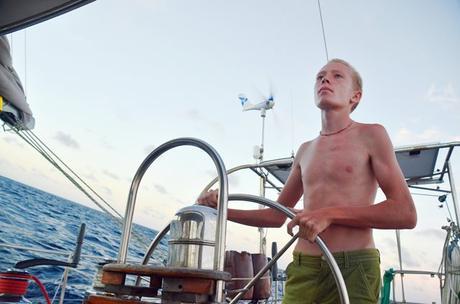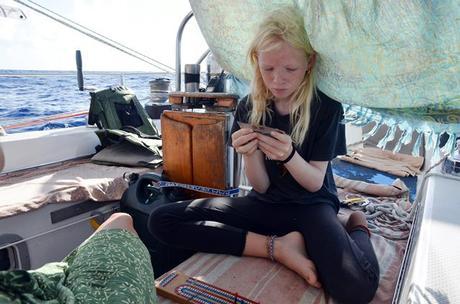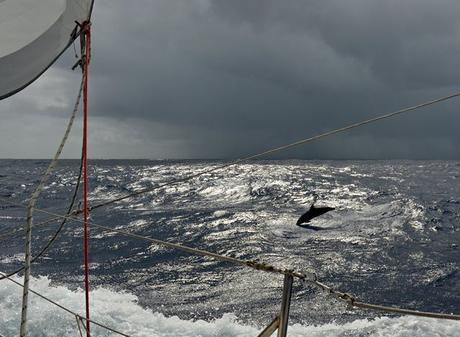
Sailing west from the middle (literally) of the Indian Ocean, to the Seychelles islands just off Africa: circumnavigate, and this may the best passage you make. “Near perfect sailing conditions have been encountered by boats making this passage in May and June” crows Jimmy Cornell’s World Cruising Routes
At just over 1,000 nautical miles, Chagos to Seychelles would be our longest passage in several years, and third longest ever. Preparing for passagemaking is never something we never take lightly, but despite the fact Chagos is uninhabited, we’ve rarely felt MORE ready. Surprises happen, regardless: when we departed Maldives in late May for Chagos, the watermaker pump head failed on our first day of the passage. It was an unfortunate start to our five disconnected weeks while visiting Chagos, and although we knew there would be well water we could filter and boil if needed, it was a relief to solve the problem through the support of the cruiser community. Friends back in Maldives had exactly the spare parts we needed for our Spectra, and another boat was departing shortly after could ferry them to Chagos.
The morning we planned to depart, we realized the stitching along the soft side to our hardtop dodger was breaking, succumbing to UV exposure. It’s only about a year old, but tropical sun is unforgiving. Jamie fixed it easily enough, his well-worn sailmaker’s palm doing service again. This felt like a good open: as if we’d headed off the one thing that would go wrong on this passage.
On this passage we’d be in company with two similar-sized sloops, one of which couldn’t use their engine. A couple of weeks previously they’d broken off their mooring in a squall and run aground on the reef, bending their prop shaft and making the engine unusable. That might not sound like a big deal—we are sailboats, after all—but there are strong currents and squalls and fluky winds here. Jamie secured stout tow lines on the stern just in case they’d be needed, and a route was planned to get us around the islands just to our west with an easy, comfortable sailing angle. Once we passed Peros Banhos atoll there was open water until Seychelles, hopefully under Jimmy’s lauded conditions.
Murphy is cruel. A few hours after leaving Salomon atoll, Totem’s autopilot started acting up. Lumpy seas loaded up force on the rudder: when Totem rounded up to port, the autopilot didn’t have enough power to steer back down. This causes the autopilot to shut off, which is better than burning out the motor, but leaves Totem suddenly without steerage. Someone is always in the cockpit, but beep beep beep…shudder shudder shudder… in rugged conditions, it take a moment to understand.
This has happened before; on the way to Australia from New Caledonia in 2010 (sailing in 30 to 35 knots), and early last year when we returned to Malaysia from Thailand. Both times, the culprit turned out to be this little washer: it has round bearings that get gummed up.

It’s not a fix we want to tackle while the boat bucks in a seaway. But at least we knew the likely problem this time, and the temporary relief, because it didn’t mean 100% hand steering for the week or so ahead. We could baby the autopilot along by ‘helping’ at the helm when the boat started to round up, taking strain off the motor and preventing it from shutting down, a vastly easier task. Meanwhile, we were in company with our friends on Utopia- an Aussie family we’ve traveled a great deal with for nearly two years- and steering for their running lights after dark was much easier than holding a compass course.

We were fortunate, at least, that those first couple of days at sea generally had the kind of conditions that give this run a reputation. Wind on the beam and favorable current pushed us along at over seven knots. We left with a new moon, and clear inky nights sparkled with the most beautiful display of stars I’ve ever seen. Sitting in the cockpit, dolphins blazing by in streaks of bioluminescence, I could time my watch to the angle of the milky way.
The back half was less pleasant. A system to the south was sending bigger seas our way, which made the motion on board a little challenging for the people and the autopilot. I’m usually not too fussed by prepping meals at sea, but we were reduced to heat-and-eat options. After such a run of mellow passages this year, I hadn’t done a lot of advance cooking. Thank goodness for canned baked beans!
The sea state also meant fewer breaks from “autopilot assist,” so one of us was always at the helm (normally, on-watch crew is in the cockpit, but comfortably in the protection of the dodger; our helm is relatively exposed). Torrential rains one night made it so miserably wet, all we could do was laugh! But the tradeoff was that we made excellent time. Boats bound for Seychelles in previous weeks had such light wind, their passage time stretched well beyond two weeks; ours was less than six days. It’s partly because we had stronger, more consistent wind, and also experience taught us to pay close attention to current near the equator, enabling us to plan a route that avoided the adverse flow they encountered.
For all the challenges, it was still a good ride. The kids are a terrific help. We had dolphin shows almost daily. Siobhan dominated me in cribbage.

Looking back… what did we do well?
- We waited for weather. We watched, we planned, and then- when we were totally ready to go, but the weather behaved differently than forecast, we waited. Our conditions were boisterous and at times intense, but in general made for a solid passage.
- We learned from other boats to inform our planning. We make active use of Predict Wind through their Offshore program (with routing algorithms that uses current data), and corroborated that information by following boats on passage to Seychelles via the twice-daily HF radio net. Several encountered significant foul current and squally ITCZ conditions on the rhumb line; went south to find the favorable countercurrent and trade wind conditions. It mostly worked.
We’re still not sure on how we’ll route from here to South Africa, but expect another lengthy passage down the Mozambique Channel before landfall in Richard’s Bay or Durban later this year. What did we learn from this passage?
- Check our autopilot washer before a long passage! A minor task, and at least there is a known culprit…the first time this happened, we thought we needed a new autopilot. Ouch.
- Have more “rough weather” meals prepped. It’s not a really big deal, there’s always *something* to eat, but we like to eat well. Low-maintenance meals are not the norm for us, and takes a little planning…but it’s worth it, because a well fed crew is a much happier crew!
And then, enjoy the ride as much as possible.

Passage dreamers and doers alike know we appreciate when you click through to read this on Sailfeed.

